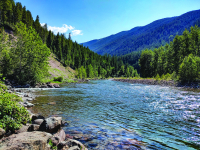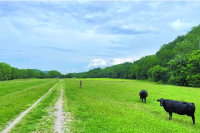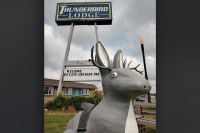An artist's legacy: New database contributes to study of George Masa's photography
 George Masa sets up for a shot at Shining Rock in 1931. Courtesy of the North Carolina Collection, Pack Memorial Library, Asheville
George Masa sets up for a shot at Shining Rock in 1931. Courtesy of the North Carolina Collection, Pack Memorial Library, Asheville
Angelyn Whitmeyer might be the last person you would expect to contribute to ongoing research surrounding a Japanese photographer who found inspiration in the Great Smoky Mountains.
And yet, the world is coming to know more about some sophisticated early images and an unlikely champion of the Great Smoky Mountains National Park through Whitmeyer’s new George Masa Photo Database.
As a kid growing up in Columbus, Ohio, Whitmeyer doesn’t recall ever visiting the Great Smoky Mountains National Park. Nor did she have a strong background in photography.
“Taking photographs was not something we did very often in my family,” she said. “I distinctly remember my conservative use of film after receiving a small camera in 1970. Should I use black-and-white, or would color be better? Processing the film was another expense I had to consider.”
Whitmeyer earned a bachelor’s degree in early childhood education from Kent State University and started her career teaching first and second grade in southeastern Ohio. She transitioned to computer programming, became a certified public accountant, and moved to Greensboro, North Carolina, in 1979. A photographer friend showed her how to process black-and-white photos in the darkroom, creating a negative and a print. She purchased a 35-millimeter camera to photograph scenes found along her travels to audit credit unions throughout North Carolina, remaining ever parsimonious in her use of film.
“When I moved to WNC in 2004, I was delighted with all the flowering native plants,” she said. “With some hesitation, I decided to purchase a digital camera. Wow! I could take lots of photos and not worry about the cost of the film, developing or making prints.”
Related Items
After several years of photographing native plants in all seasons, Whitmeyer created a website to assist people with plant identification. From there, she became interested in women photographers from the beginning of photography in 1839 through the 1950s and taught a series of courses on the topic at Asheville’s Osher Lifelong Learning Institute. The research piqued her interest in early photographers of Western North Carolina.
“I came up with a list of potential photographers to research, then looked on the internet for books about the person and for photographic archives of their work,” she said. “George Masa’s name appeared on the initial list of photographers. The two sources of information about him were William A. Hart Jr.’s essay ‘George Masa: The Best Mountaineer’ and Paul Bonesteel’s film ‘The Mystery of George Masa.’”
Born in Japan, Masa came to the United States in 1906. His background and first nine years in the U.S. have been shrouded in mystery, but those familiar with him know that he came to Asheville in 1915 to work at the Grove Park Inn. Photography eventually became Masa’s vocation, but his avocation was hiking in the mountains of Western North Carolina — and in the Smokies in particular. Eventually, he would help bring attention to the Great Smoky Mountains as an ideal location for a new national park.
“He was an artist who composed and captured scenes of the Smokies with the same focus and intensity that is employed by master painters,” said Bill Hart, whose writing inspired a renewed interest in Masa. “He was especially attentive to the effects of light and shadow as well as to cloud formations, often waiting hours for the ideal combination of light, shadow and cloud effects.”

Lake Junaluska was one of many WNC landscapes captured by George Masa. George Masa Photo. Courtesy of E. M. Ball Photographic Collection, D.H. Ramsey Library, Special Collections, University of North Carolina - Asheville.
Whitmeyer was particularly intrigued by some color postcards made from Masa’s photographs at Chimney Rock and included in Hart’s essay, but she soon found it impossible to purchase or share them with class participants. The lack of available prints for purchase, along with the fact that the postcards did not have any signed reference to Masa, reinforced what she’d learned from Hart’s essay, Bonesteel’s film and notes on items found on Pack Library’s special collections digital site — much of Masa’s work, like that of many of the early women photographers, had been “lost” or destroyed.
Whitmeyer began to cross-reference the postcards with pages from the Pack Library site and prints in their collection. She studied Masa negatives at the Ewart M. Ball Collection at University of North Carolina Asheville’s Ramsey Library special collections and made connections between them and the Pack information. Organizing this data and making detailed observations as she compared images, Whitmeyer decided to create a database of all the George Masa images she could find.
Announced in November, the database of 4,000 data points includes the Pack Library collection, which has digitized a substantial number of prints found by Jami Daniels in the Daniels Graphics Miller Printing Collection; the Ball Collection at Ramsey Library; the Highlands Historical Society collection; and the collections at Western Carolina University and the Great Smoky Mountains Association, which were donated by Libby Kephart Hargrave. Bill and Alice Hart graciously permitted access to their personal assemblage of Masa and Western North Carolina ephemera, allowing Whitmeyer to document subsequent uses of Masa’s photos in publications such as brochures and booklets. The result is nearly 1,800 unique images and 2,200 subsequent uses of those photos in various publications from the 1920s until today.
“Angelyn’s database is a labor of love — and dedication,” said Janet McCue, who coauthored “Back of Beyond: A Horace Kephart Biography” (GSMA 2019) with the late George Ellison and is now collaborating with Bonesteel on a new biography of George Masa to be published by the Great Smoky Mountains Association this fall. “For a researcher, it’s the best source for discovering which archive holds a copy of any particular Masa photo.”
Bonesteel said Whitmeyer’s database represents an immense tool for understanding the breadth of Masa’s work.
“His thousands of photos just exploded across the region after his death — with many gone forever — but her work dissecting Masa’s records has allowed her to make sense of the chaos, categorizing and organizing the ones we have — and even the ones we don’t,” Bonesteel said.
The next in a short line of scholars before her, Whitmeyer has been bitten by the “Masa bug” and contributed skills she has honed throughout her life to do this important work. Her “accounting” has brought together the known Masa photos into one database and clarified the scope of lost images as well.
“No one has ever compiled all of this information into one source before,” said McCue. “What’s even better is that she’s still discovering more.”
Whitmeyer hopes people will “look in the attic, in the box in the closet or in an old scrapbook and find those photographs taken by George Masa that the rest of us have yet to see.”
Add to the database
Angelyn Whitmeyer welcomes anyone who knows of images that could be included in the database to get in touch with her. Find out more by visiting georgemasaphotodatabase.com and reach Whitmeyer at This email address is being protected from spambots. You need JavaScript enabled to view it..
(Frances Figart (rhymes with “tiger”) is the editor of “Smokies Life” and the Creative Services Director for the 29,000-member Great Smoky Mountains Association, an educational nonprofit partner of the Great Smoky Mountains National Park. GSMA provided this piece as part of its “Word from the Smokies” series of columns. Reach Figart at This email address is being protected from spambots. You need JavaScript enabled to view it..)

















